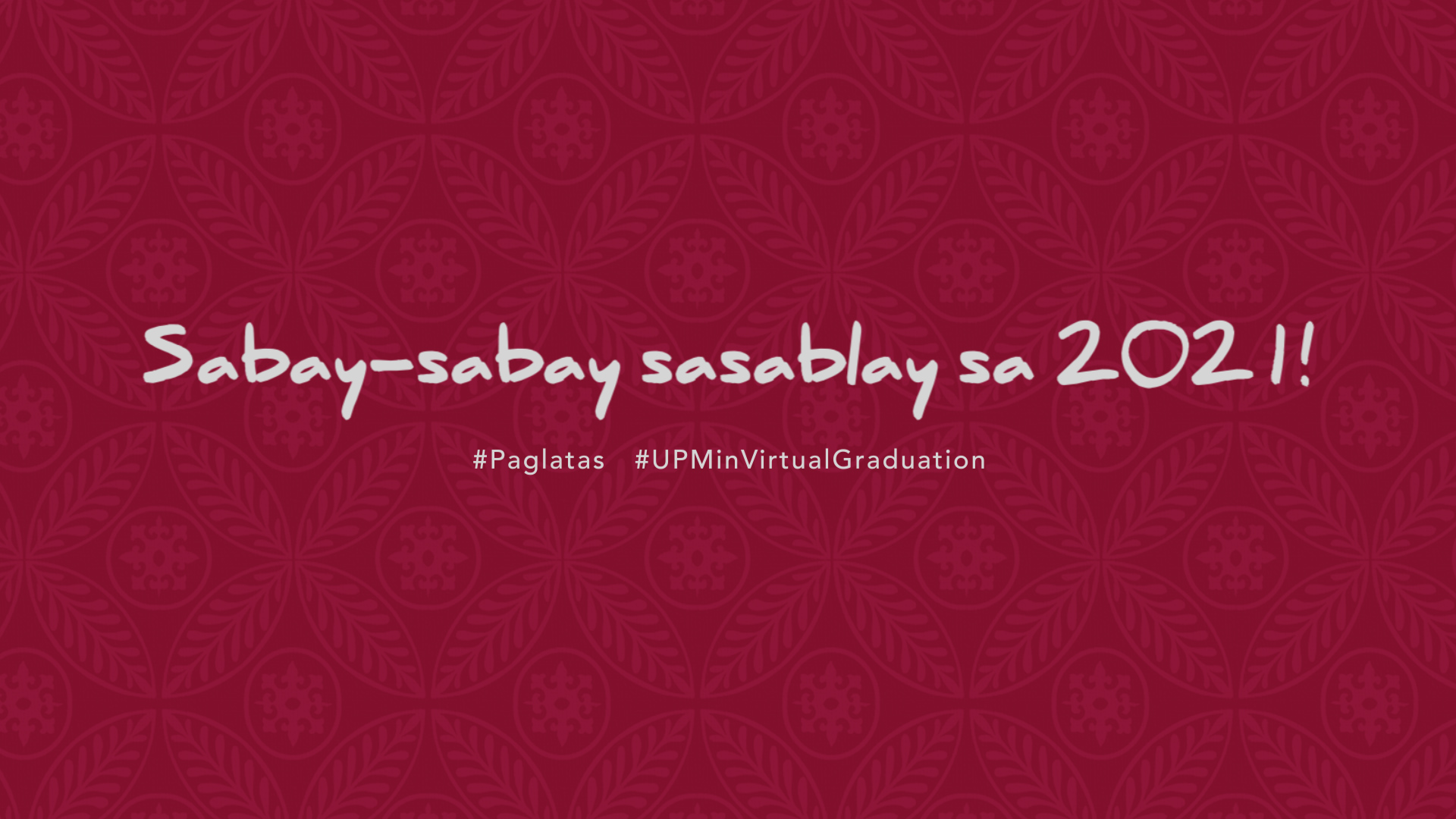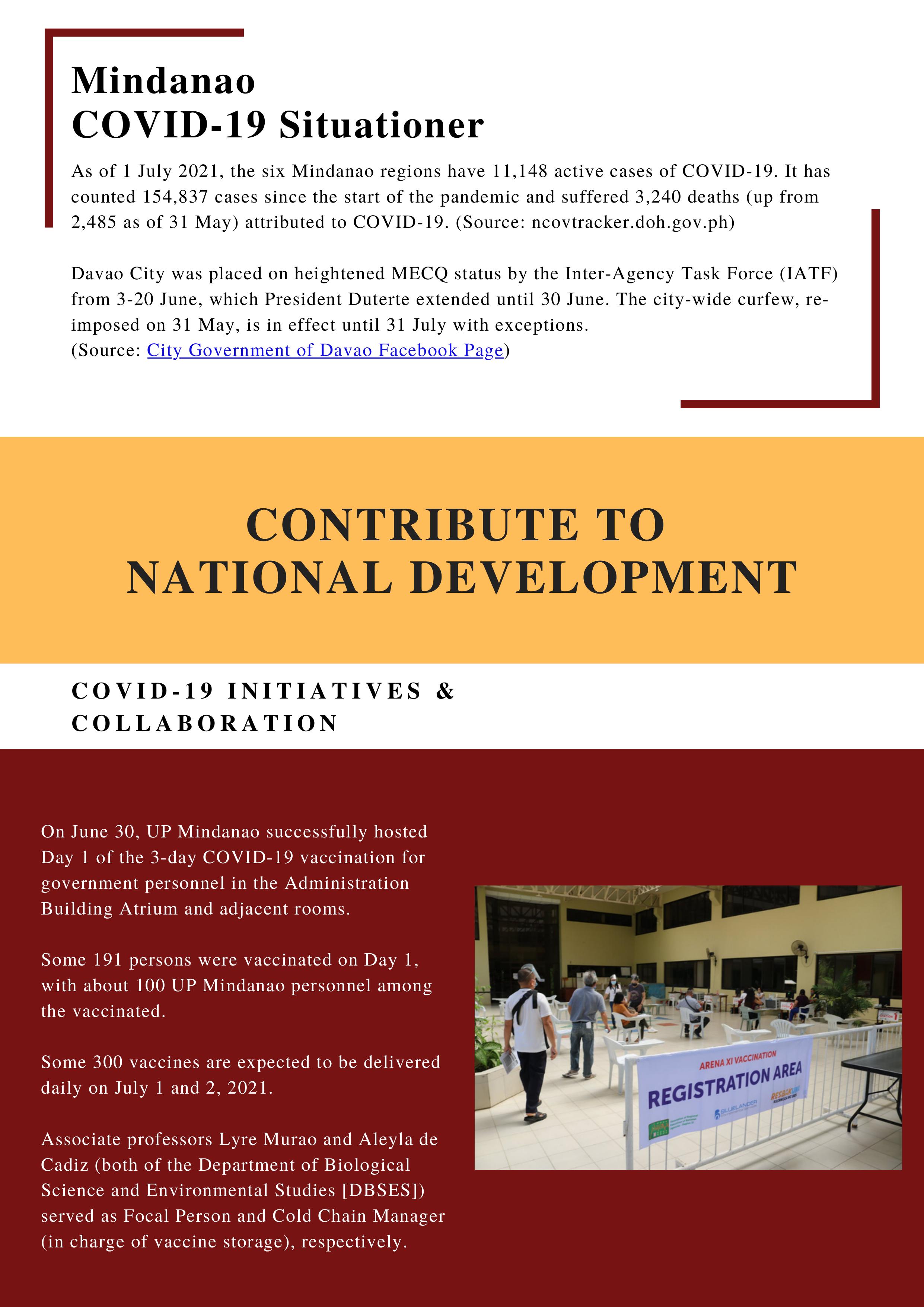Commencement Message of Dr. Emil Q. Javier, 2021
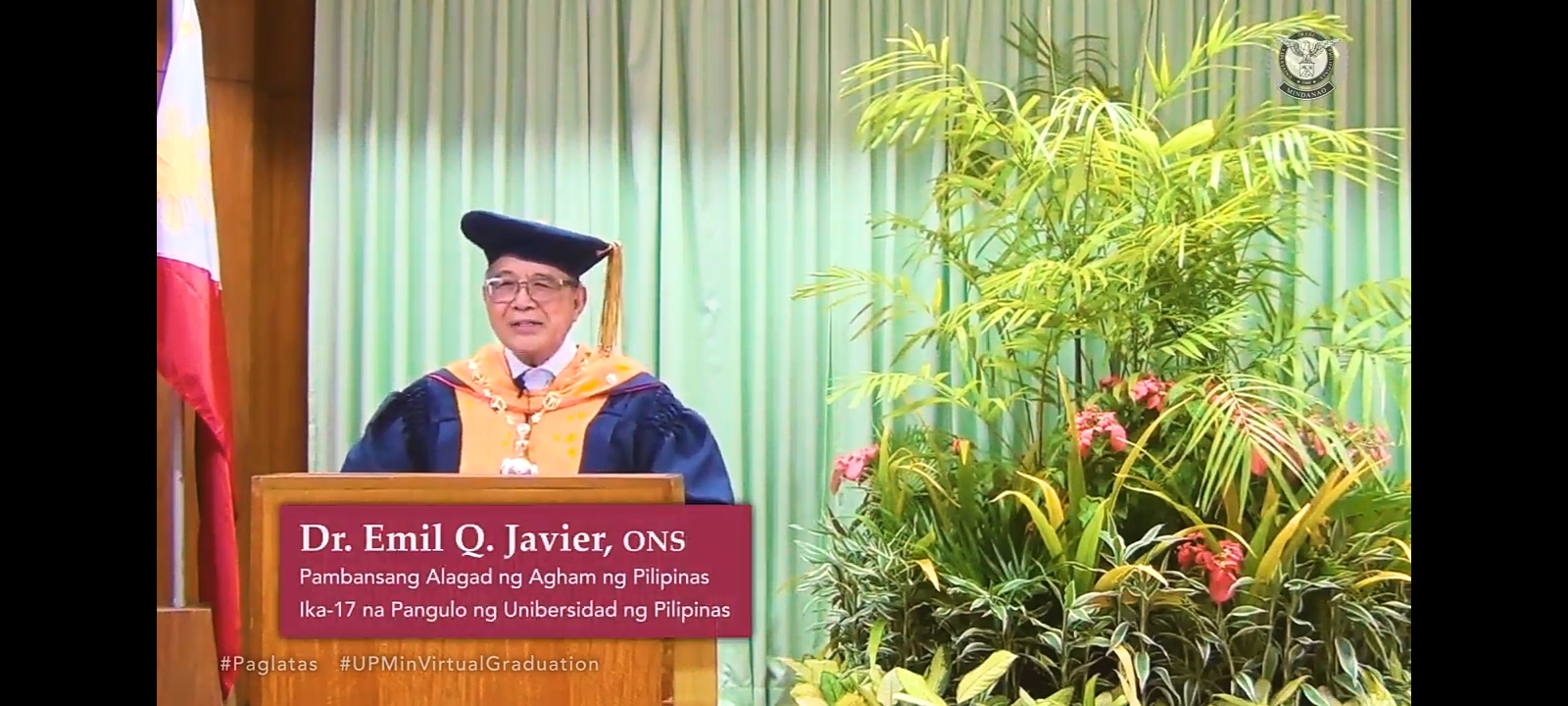
Dear Parents, Guardians, Faculty, Staff, Students, Alumni, the Graduates of 2020 and 2021, Distinguished Guests, Ladies, and Gentlemen
A pleasant morning to all of us.
It is my honor and privilege to be asked to deliver a parting message to the UP Mindanao graduates of 2020 and 2021.
As many of us know, UP Min was established 26 years ago during my term as university president. Seeing how far the university has progressed, I take a lot of pride and satisfaction with being associated with its founding.
I have always meant to but I never got around doing it — publicly recognizing and thanking the men and women who were responsible for its birth. But who regretfully had remained anonymous and largely unappreciated.
I hope you will not mind if I take this unique opportunity to make amends and name these generous men and women and share with you interesting vignettes of their contributions.
First, if there were a group of people who rightfully ought to be credited for the establishment of UP Min, these were the loyal UP alumni of the Davao City chapter led by its long-term President Sebastian Angliongto and his partner in crime, John Gaisano.
With him were other similarly very enthusiastic UP alumni like Sid Ungab, Sonny Puyod, Aida Reyes, Agnes Togon, Danny Guillen, Bobby Ramos, and Doris and Rico Villareal.
Second, very appropriately, we have named the men’s dormitory after the late congressman Elias Lopez who has the distinction of being the principal author of Republic Act 7889 establishing UP Mindanao and being referred to as Father of UP Mindanao.
However, Elias Lopez was not the first because in fairness to the late congressman Prospero Nograles Sr., the latter filed an earlier bill in the previous Congress which however lapsed.
Elias Lopez was an eloquent, forceful and colorful advocate and was a lot of fun to work with as we steered the UP Mindanao bill through Congress.
I have two interesting anecdotes about Elias Lopez:
First, the street-smart lawyer that he was, Elias Lopez filed the UP Min bill as a LEGISLATION OF LOCAL APPLICATiON. Congressional hearings of this kind of local bills are hardly noticed. The presence of the Committee Chairman, the principal author and one or two congressmen witnesses would suffice to constitute a quorum.
Thus, with Congressmen Salvador Escudero III, who was the Education Committee Chairman, Elias Lopez as proponent and Simeon Datumanong, the UP Min bill breezed through the required hearings.
When I asked Elias Lopez for his explanation why he filed the UP Min bill as a local bill, this was his smart reply: Mr. President, creating UP Min is no different from establishing a new high school in Davao City and therefore should not be of much concern to the other congressmen.
The second anecdote about Elias Lopez was at the Senate hearings, when opposition senator Ernesto Maceda asked me point-blank whether there were squatter families who will be displaced in the UP Min reservation at Bago Oshiro.
Before I could reply, Elias Lopez as a congressman who had no business being in the hearings, broke protocol, barged into the Senate floor, grabbed a microphone and declared there were no squatters.
Over lunch I chided Elias Lopez that we were not exactly truthful in the hearing because both of us knew there were at least 64 informal settler families we had to mollify, compensate and relocate.
Elias Lopezes’ explanation was as follows: Mr. President, a Filipino can not be a squatter in his own homeland. Ergo, there are no squatters in the UP Min reservation.
The third person to whom UP Min owes a lot but who remains anonymous was the then Secretary of the Department of Environment and Natural Resources and UP Mass Com alumnus, Victor Ramos.
UP Min is very fortunate to be endowed with three land grants. I am not aware of any other SUC with as many properties. In addition to the Bago Oshiro main campus, our fellow alumni from College of Forestry upon instruction of Victor Ramos set aside a 5,000-hectare secondary forest reservation at Marilog at the Davao-Bukidnon border, as well as a 3,000-hectare forest concession in Laak Town in Compostela Valley.
Secretary Victor Ramos drafted the three necessary presidential proclamations assigning them to the University of the Philippines and made sure President Fidel V. Ramos signed them before our terms of office were over.
Incidentally, we had no difficulty carving out the 204-hectare reservation out of the Bago Oshiro Bureau of Plant Industry (BPI) Experiment Station courtesy of the BPI director, Nereus Roperos, a UPLB graduate, who was only too happy to oblige.
The Laak land grant had a little story to it. The young mayor of Laak, whose name escapes me, took graduate studies at the National College of Public Administration and Governance (NCPAG) in UP Diliman. He was only too happy to endorse to FVR that the forest be granted to UP instead of falling into the hands of loggers.
But the Laak mayor had one request: for UP to help him establish a high school, which we did. We fielded four courageous young women Gurong Pahinungods from UP Visayas under the tutelage of Prof. Ruben Gamala to constitute the pioneer faculty. UP contributed steel bars, nails, GI roofing, and bags of cement while the local government supplied lumber, sand, gravel, and labor to construct the high school buildings.
For continuity, I got the assurance of the then Department of Education Secretary Brother Andrew Gonzalez that the UP-Laak High School will be incorporated into the public school system in the following fiscal year.
There are accounts in the establishment of UP Mindanao that as president of UP I was summoned to Malacanan by President FVR and was given instructions to proceed with the establishment of UP Mindanao.
This narrative is not true. FVR was very proper in his dealings with the University and respected our academic autonomy. He was aware of the alumni initiative to establish UP Mindanao but FVR left it to the Board of Regents (BOR).
In fairness to the BOR, the Regents did not need any prompting from the President. If at all, it was the BOR who gave me the full authority to proceed.
In addition to BOR Chairman Armand Fabella, the two other principals were Senator Leticia Ramos-Shahani and Congressman Sonny Escudero who were respective chairs of the education committees in Congress.
The other regents were as supportive among them: Regents Antonio Carpio, Oscar Alfonso, National Scientist Paulo Campos, Nelia T. Gonzalez, Emerenciana Arcellana, alumni regent Ed Espiritu and Student Regent Dennis Cunanan.
I will be remiss if I fail to recognize Fortunato de la Pena, now Secretary of the Department of Science and Technology (DOST). Prof. Boy de la Pena was UP Vice President for Planning and Development and he was in fact the point-man in orchestrating all the university efforts, including the preparation of the Bago Oshiro campus development plan with landscape specialist Fernando Sanchez, Jr., former UPLB Chancellor.
Finally and not by any means the least, we need to recognize the profound role of UP Min founding Dean, later Chancellor Roger Cuyno and the pioneering faculty. Roger Cuyno was there from the beginning in the conceptualization and planning stages, in organizing the programs and recruiting faculty and mobilizing national and local support to the institution.
Roger Cuyno came very well prepared for this role. As a native of Mindanao himself (from Surigao), his heart was in the right place. He has a doctoral degree in communications and development management from Michigan State University. Years before he played a key role in the training of thousands of rice extension technicians in Masagana 99 and the institution of research management as a discipline at UPLB, other state universities and colleges and at Philippine Council for Agriculture, Aquatic and Natural Resources Research and Development (PCAARRD) of the DOST.
UP Min had a good running start, thanks to the excellent faculty which UP Los Banos and UP Diliman so generously shared with their young sibling university.
Among the pioneer faculty were: Academician Eufemio Rasco, Jr., Tony Moran, Dulce Flores, Ruth Gamboa, Leonardo Chua, Fedeserio Camarao, Nelson Natural, Erwin Protacio, Bert and Carol Santillana from UP Los Baños, and Marcy Dans, Tess Vivas-Guillen, Aniceto Poblador and Jose Garrido from UP Diliman.
Transcending the Pandemic: A Resilient Recovery towards the New Normal
Now let me proceed with my assignment. In the first place the COVID 19 epidemic is a novel experience for all of us. A lot are still unknown about this virus. We were fortunately spared from the two most recent global epidemics — SARS and MERSCOV — both of which like COVID 19 were zoonotic in origin, meaning they were pathogens which jumped from livestock and wildlife to humans.
For this reason, the UP College of Veterinary Medicine anticipating there will be more to come has proposed to the BOR a National Center for Zoonotic Diseases, to join the other National Institutes of Health in UP Manila.
The pandemic is far from over but at least for now the transmission rates in the centers of population — NCR, Regions III, and IVA have moderated.
However, there are new threats from viral mutations among which the Delta variant from India has been identified as more virulent i.e. more quickly transmitted among the unvaccinated than the original pathogen. Another variant, designated Theta, originating from the Philippines was just recently reported.
The good news is that although the available vaccines are slightly less effective in preventing the transmission of the new variants, the vaccines were still very efficient in preventing severe disease, hospitalization, and death.
Since the pandemic is far from over, it is difficult to be upbeat. However, the incorrigible optimist that I am, I am sanguine that as depressing as it might be now, COVID 19 just like all previous pandemics will too come to pass.
Our immune systems will eventually reach an equilibrium with the pathogen. There will be herd immunity in the population and as before, the human race will go on.
It is not a matter of WHETHER, but WHEN will, nations or specific sectors of populations attain herd immunity both from natural infection and through artificial inoculation, i.e. by vaccination.
In theory, the expedient course is to just allow the contagion to go through the population quickly, attain herd immunity and get it over with.
However, this fatalistic but scientifically-based course will come at a cost. If left unchecked, the surge of patients will overwhelm the hospitals, leading to mortalities many of whom could have been saved with appropriate and timely medical interventions.
This, therefore, is not politically correct nor morally acceptable given the fact that many of the unnecessary mortalities could be prevented by vaccination.
Sweden initially took this natural infection course but had to relent after their fatalities per million inhabitants soared compared with their northern European neighbors.
Fortunately, with the advances in molecular biology and resolute actions of some governments and the global pharmaceutical industry, many candidate vaccines became available within 12–18 months, instead of the tens of years it previously took to develop and bring new vaccines to the market.
So, the race among nations is to acquire the needed number of doses of vaccines with which to inoculate about 70% of their respective populations to approach herd immunity as quickly as possible.
And so, this is where the world is now. The developed nations with cash to spare and who had made advances in procurement are cornering the global supply of vaccines.
The rates of infections per million inhabitants have begun to come down among these fortunate countries.
Our IATF assures us that we too would have 70% of Filipinos vaccinated by end of 2021.
However, at the rate we are going, more likely if ever, we may have sufficient vaccines only by mid-year 2022, in time for the national elections.
Therefore, in the meantime, the best that we can do is, even after being vaccinated, to continue wearing masks, avoiding crowds, and washing our hands. We have to persevere in adopting these sanitary measures to slow down virus transmission so as not to overwhelm our national health service.
Of course, this means shutting down factories, hotels, malls, curtailment of travel, and transport of goods and services, causing massive unemployment and food insecurity. Our people are suffering and we have to raise ourselves out of this recession as soon as possible.
The challenge is carefully calibrating the deployment of vaccines as they become available, particularly for NCR and Regions III and IVA and other urban centers like Cebu, Davao, and Baguio where rates of infections are highest and where most factories and productive enterprises are located.
Of course, this is easier said than done although in fairness, the national and relevant local governments, are doing their best.
In fact, if we were to be hard-nosed about this, the quicker way to attain herd immunity is to open the schools. The young are not immune to COVID-19 but will also contract COVID-19 but most young people will be asymptomatic and display only mild symptoms. Hospitalizations and deaths will be rare compared with adults.
Many of our school districts are not ready for remote learning and it is best we open the school as soon as possible. This means we should prioritize the vaccination of teachers and employees in schools.
So, we go back to the theme as I premised sooner or later with more vaccinations we shall transcend, overcome and go past the pandemic. But how do we prepare as individuals, as communities, and as a nation for the disruptions and aftershocks?
In the first place, all of us have to come to the realization that the pandemic undeniably has changed the way people live and work. The transformations are most pronounced in remote work, e-commerce, and automation. Most of the bureaucracy, teachers, and office workers now work at home. There is more digital banking and e-commerce, leading to partial shutdowns (and bankruptcies) of brick-and-mortar stores, restaurants, malls, and banks. More and more medical consultations are being conducted by telephone and video conference.
But actually, these global trends had been going on in the developed economies for a few years now. The pandemic simply accelerated the roll-out of these modes of conducting businesses and transactions.
And for less developed countries like ourselves, the pandemic simply brought the future much earlier than expected, unfortunately way before we are ready.
So, what exactly are these global trends in technology and modes of conducting business that will define the years after the pandemic.
In a survey of 18,000 business executives and managers in 15 countries, the global consulting firm McKinsey came up with the following ten most important trends:
1.next-generation computing
2.applied artificial intelligence, machine learning, and robotics
3.distributed infrastructure
4.trust architecture
5. future of programming
6.future of connectivity
7.bio-revolution
8.next-level process automation and visualization
9.future of clean technologies, and
10.nanotechnology and next-generation materials.
I am afraid these are a mouthful of ideas to discuss at this time but the message I want to bring across to you graduates is that these are some of the global trends which you need to prepare and acquire skills for both from a personal career point of view as well as part of your obligation of mga ISKOLAR PARA SA BAYAN.
Our national capability to compete and take our rightful place among nations rests heavily on your shoulders. You, representing the crème de la crème of the next generation, must comprehend, acquire and master these modern technologies to advance our national purposes.
Better yet, many of you who are so inclined should consider engaging in research and generation of these technologies to enhance our national competitiveness.
And finally, sorry to cram all these at this late hour, but the work environment you will find yourselves in will be very different from those our generation faced.
To thrive in the new normal, you must be prepared to operate remotely, innovate and adapt.
But the new global workplace trends affect occupations and professions differently. McKinsey estimates that 14% of employees need to be fully re-skilled while 40% need to be partially re-skilled.
McKinsey identified four vitally important skill sets you need to master, as follows:
1.digital skills — ability to operate at pace in a fully digital environment,
2.cognitive skills — problem-solving skills to redesign and innovate in an increasingly autonomous environment,
3.social and emotional skills — to ensure effective communication and collaboration and interpersonal skills to cultivate relationships that used to be nurtured in person, and
4.adaptability and resilience — ability to manage time boundaries and mental wellness.
As I close, let us acknowledge and thank the parents, guardians, and faculty for their efforts in helping our young graduates for the real world ahead of them.
To our dear graduates of 2020 and 2021, as alumni of UP, much more are expected of you to provide inspiration, direction, and leadership not only in your places of work but also in your respective communities, and circles of family and friends.
I trust that we have inculcated in your minds your special obligation to excel in the disciplines and professions but also serve as exemplars as selfless volunteers (Pahinungods) in society.
This COVID-19 pandemic realistically won’t be over soon and may take a year or two before economic and social activities settle down. COVID-19 will probably never go away but will stay around like the seasonal flu.
But the new normal will be heavily influenced by technological trends, like the ones I breezed through which our graduates need to prepare for and master themselves for our country’s future.
Mabuhay ang UP Mindanao graduates of 2020 and 2021. Mabuhay tayong lahat.
###
Emil Q. Javier
National Scientist and
President, University of the Philippines (1993–1999)
July 13, 2021

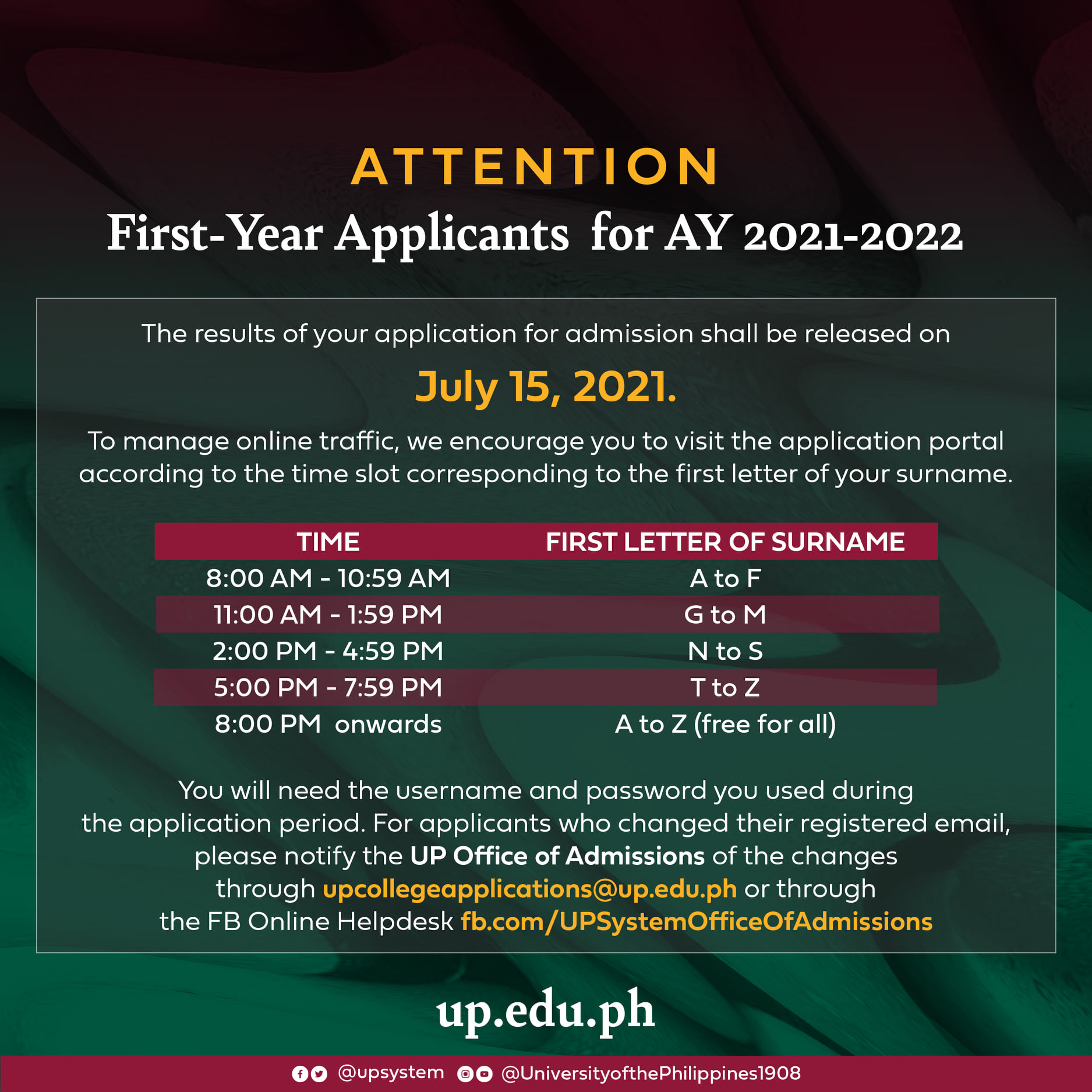
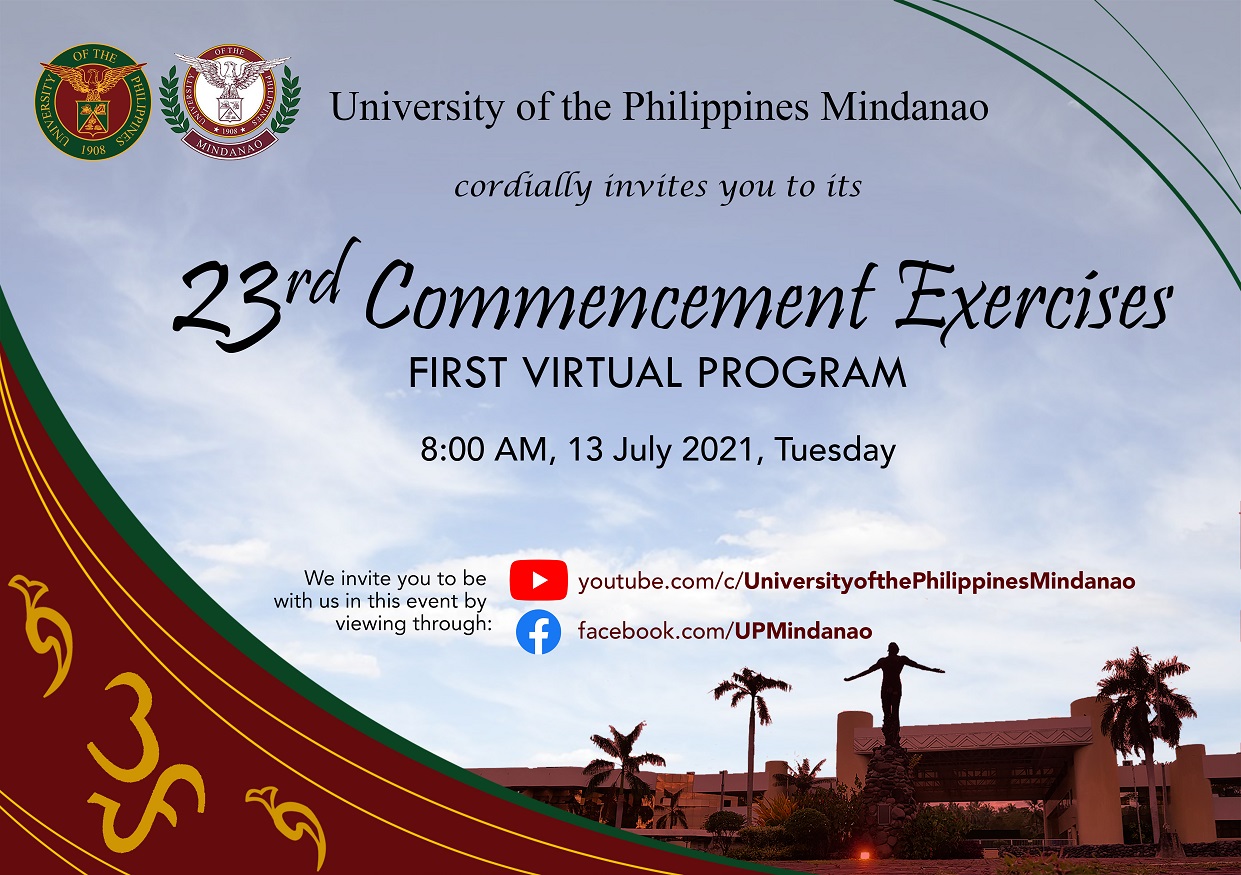
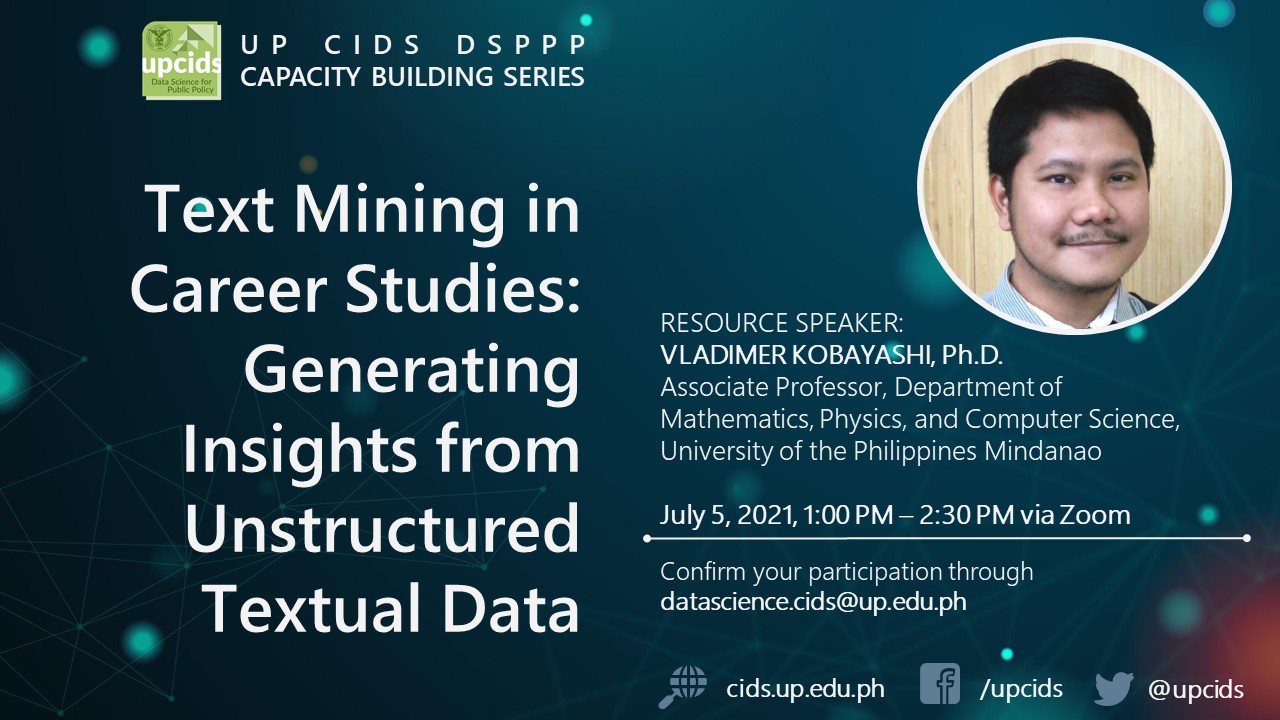 The Program on Data Science for Public Policy of UP CIDS invites you to the first installment of our Program’s Capacity Building Series, entitled “Text Mining in Career Studies: Generating Insights from Unstructured Textual Data” Career Studies: Generating Insights from Unstructured Textual Data” happening on July 5, 2021, 1:00 PM to 2:30 PM, via Zoom.
The Program on Data Science for Public Policy of UP CIDS invites you to the first installment of our Program’s Capacity Building Series, entitled “Text Mining in Career Studies: Generating Insights from Unstructured Textual Data” Career Studies: Generating Insights from Unstructured Textual Data” happening on July 5, 2021, 1:00 PM to 2:30 PM, via Zoom. 